
Painting with Found Materials
We were inspired by one of Eric Carle’s artistic processes, where he paints tissue papers to later use in collages. While he uses a paintbrush to paint, he has also used found materials to make marks including carpet squares and brooms. Inspired by how materials can be stamped, pulled, and pushed across the paper, we decided to create a project that allowed for color-mixing and painting with found objects.
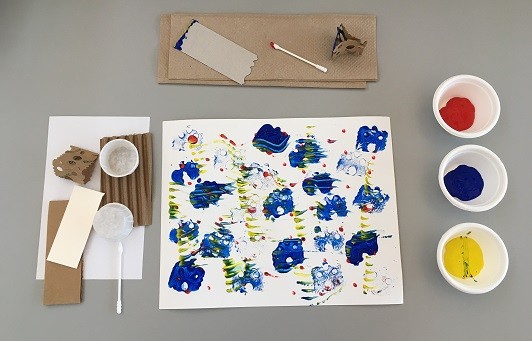
Paint Selection
To encourage paint mixing, we chose to provide all three primary colors of Crayola washable tempera paint in condiment containers. Over time, we discovered that a little paint goes a long way! So within the 2-ounce condiment container, we only needed to put in a thin layer of paint at the bottom of the cup.
Found Materials
With sustainability in mind, we decided to experiment with paper found materials as tools to paint with. Each bag has 10 items to paint with, including cardboards, cotton swabs, and cups.
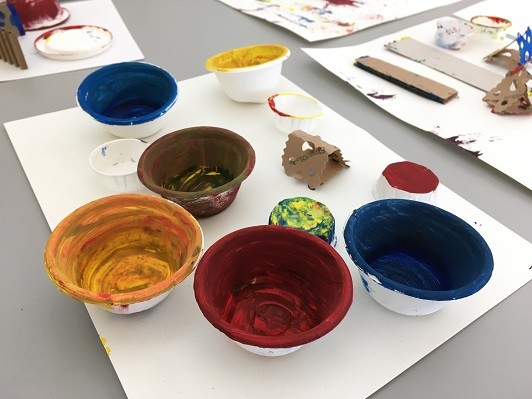
Using paper materials allows us to provide materials to give away in our Art Project to Go! bags as well as create beautiful painted materials that we could use again in collage or sculpture projects.
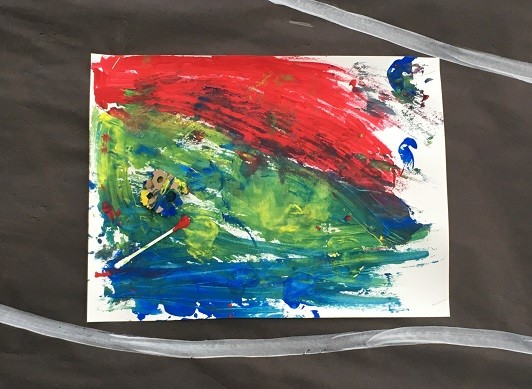
Reflection
Having facilitated the project for three weeks at this point, we are confident that the materials and paint provide rich opportunities for printmaking, color-mixing, and self-expression. Our choice of cup sizes and paint amount means that there isn’t a lot of paint to wipe up before the next group if it transferred to the table or stools. Our choice of paint, Crayola washable tempera paint, also helped with clean-up as it is truly washable and wipes off of surfaces very easily with just a damp cloth. In addition, over time, we decided to reduce the number of painting supplies (from 16 to 10) in noticing that most people didn’t use all the materials. It significantly cut down on our cleaning time, allowing us to quickly reset the table before the next group.
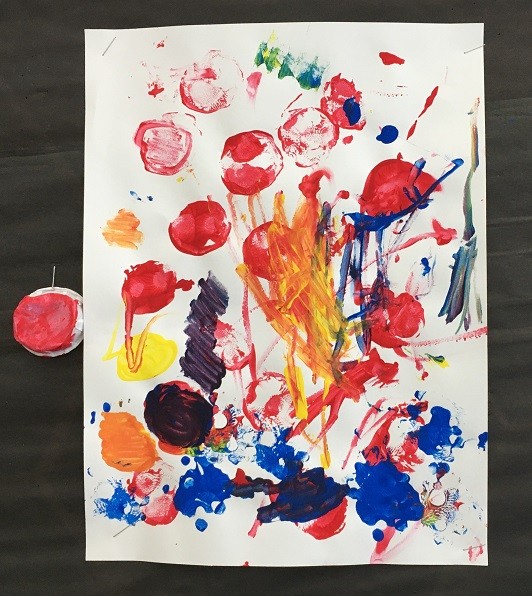
For the installation, we encourage guests to leave behind their favorite tool they used to make their painting. It has been fun to match up the marks to the tool, while also providing a variety of examples for inspiration.
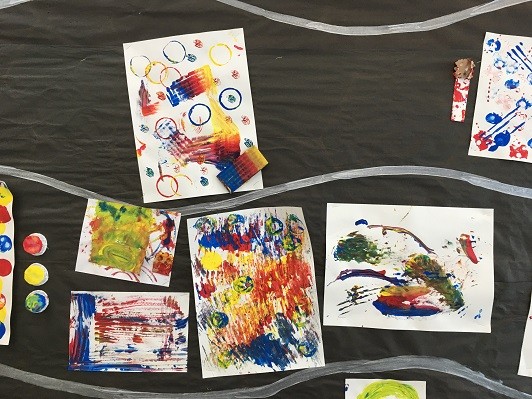
We found with this paint project, as with all of our other paint projects, the time spent working on the materials and design was worth it. Clean-up and material management will always be a big factor when using paint with young children, but the joy and learning children get from the medium is so apparent whenever we use it. We hope that some of the things we have learned along the way about paint in a busy Art Studio are helpful to you as you design and plan your own painting projects and spaces!
Adaptations for Your Learning Environment
Through a Service-Learning Program at Holyoke Community College in spring of 2023, Professor Sheila Gould and Curriculum in Early Education 210 students adapted this project for their learning environments. They had insightful suggestions for other educators who are looking to adapt this project. Check out below some suggestions on materials to use and adaptations for your learners’ needs. Thank you Andrea, Carissa, Katherine, Kristy, Kiara, Megan, Serenity, and Sheila for the feedback!
Material suggestions
To help this project be more engaging for your learners, try using objects that they are unfamiliar using with paint. Below are a few suggestions you might consider using.
- Toy cars
- Mason jar rings
- Party bead necklaces
- Things from the outside: sticks, leaves, rocks, flowers
- Things from the bathroom: cotton swabs, cotton balls, a loofah
- Things from the kitchen: muffin liners, food scraps, forks, spoons, cookie cutters, cups
- Things from the recycling bin: paper towel tubes, plastic lids, plastic containers
- Things with a certain shape: circles, rectangles, triangles
- Things that the learners collect: work with your students to collect the materials to see what they are interested in painting with
- Homemade tools: clip together a textured material such as mesh, packaging material, plastic wrap, etc with a clothes pin, wrap a dowel or pencil with a textured material and attach with a rubber band
Adaptations for your learners
As with any art making project, it is important to consider your learners’ needs and adapt accordingly to make sure it is an engaging and enriching experience. Below are a few of the adaptations suggested that might help your learners.
- Adaptations for learners developing fine-motor skills: using objects that they can already grasp such as larger objects or household objects, using larger trays to hold the paint
- Adaptations for learners with sensory challenges: long-handled objects such as spoons and fly swatters to avoid touching the paint, providing gloves for the learners, putting the paint inside of a plastic bag and making impressions in the paint using the tools
- Adaptations for learners with developmental disabilities: using objects that they are familiar with such as household items or toys, using objects that the learners can grasp such as larger objects

